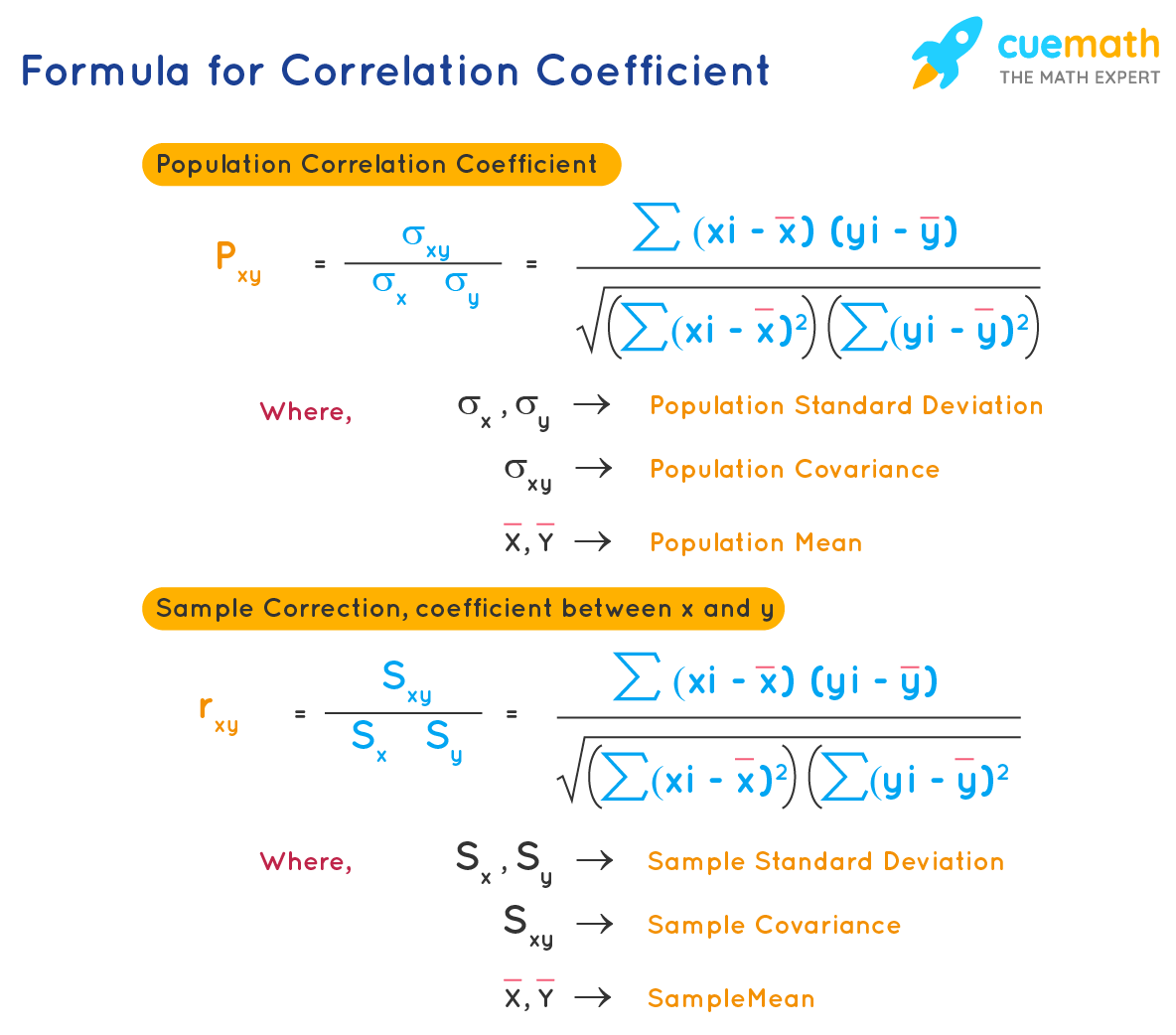How To Find The Sample Correlation Coefficient
Correlation Coefficient Formula
In statistics, correlation is a way of establishing the relationship/association between two variables. In other words, the correlation coefficient formula helps in calculating the correlation coefficient which measures the dependency of one variable on the other variable. Correlation is measured numerically using the correlation coefficient. The correlation coefficient lies between -1 and 1. A negative correlation coefficient indicates that the human relationship between two variables is inverse. A positive correlation coefficient indicates that the value of ane variable depends on the other variable directly. A cypher-correlation coefficient indicates that in that location is no correlation between both variables. There are many types of correlation coefficients, among them, the Pearson Correlation Coefficient (PCC) is the almost common ane. Permit us explore how to calculate the correlation coefficient formula for a given population or sample beneath.
What Is the Correlation Coefficient Formula?
The correlation coefficient is a statistical concept. Information technology establishes a relation between predicted and actual values obtained at the end of a statistical experiment. The correlation coefficient formula helps to calculate the relationship betwixt two variables and thus the upshot so obtained explains the carefulness between the predicted and actual values.

Pearson Correlation Coefficient Formula:
1. Sample Correlation Coefficient
The formula for pearson correlation coefficient for population of sizeN(written equallyρX, Y ) is given as:
\(\rho_{10, Y}=\frac{\operatorname{cov}(X, Y)}{\sigma_{10} \sigma_{Y}}=\dfrac{\sum_{i=1}^{north}\left(X_{i}-\bar{X}\correct)\left(Y_{i}-\bar{Y}\correct)}{\sqrt{{\Sigma}_{\Sigma_{i}=i}^{north}\left(X_{i}-\bar{Ten}\right)^{two}} \sqrt{{\sum}_{\Sigma_{i}=1}^{n}\left(Y_{i}-\bar{Y}\right)^{two}}}\)
where covis the covariance and (cov(Ten,Y)= \(\frac{\sum_{i=ane}^{Northward}\left(X_{i}-\bar{Ten}\right)\left(Y_{i}-\bar{Y}\right)}{Northward}\), σX is standard divergence of XandσY is standard divergence of Y.
Given X and Y are two random variables.
2. Population Correlation Coefficient
The formula for pearson correlation coefficient for sample of sizedue north (written asrxy ) is given as:
\(r_{x, y}=\frac{\sum_{i=1}^{north}\left(x_{i}-\bar{x}\correct)\left(y_{i}-\bar{y}\correct)}{\sqrt{\Sigma}_{\Sigma_{i}=1}^{northward}\left(x_{i}-\bar{x}\correct)^{2} \sqrt{\sum}_{\Sigma_{i}=1}^{n}\left(y_{i}-\bar{y}\right)^{2}}\)
wherenis the sample size,xi&yiare the ith sample points andx̄&ȳare the sample ways for the random variables X and Y respectively.
Given X and Y are ii random variables.
3. Linear Correlation Coefficient
It uses pearson's correlation coefficient to determine the linear relationship between two variables. Its value lies between -1 and 1. It is given every bit:
\(r=\frac{n(\Sigma x y)-(\Sigma ten)(\Sigma y)}{\sqrt{\left[n \Sigma ten^{2}-(\Sigma x)^{2}\right]\left[n \Sigma y^{2}-(\Sigma y)^{two}\correct]}}\)
wherenis the sample size,xi&yiare the ithursday sample points andx̄&ȳare the sample means for the random variables x and y respectively.
The sign of r indicates the strength of the linear relationship between the variables.
- If r is almost 1, and then the ii variables have a potent linear relationship.
- If r is near 0, and then the two variables have no linear relation.
- If r is near -1, then the two variables have a weak (negative) linear human relationship.

Suspension downwardly tough concepts through uncomplicated visuals.
Math will no longer be a tough subject, especially when you understand the concepts through visualizations with Cuemath.
Book a Costless Trial Class
Let us see the applications of the correlation coefficient formula in the post-obit section.
Examples using Correlation Coefficient Formula
Case 1.Given the following population data. Find the Pearson correlation coefficient between x and y for this data. (Accept 1√7 equally 0.378)
| x | 600 | 800 | thou |
| y | 1200 | thou | 2000 |
Solution:
To simplify the calculation, we divide both x and y past 100.
| x/100 | y/100 | \(x_{i}-\bar{x}\) | \(y_{i}-\bar{y}\) | \(\left(\mathrm{ten}_{\mathrm{i}}-\overline{\mathrm{x}}\right)^{ii}\) | \(\left(\mathrm{y}_{\mathrm{i}}-\overline{\mathrm{y}}\right)^{2}\) | \((x_i - \bar{x})(y_i - \bar{y})\) |
| 6 | 12 | -two | -ii | four | 4 | 4 |
| viii | 10 | 0 | -4 | 0 | 16 | 0 |
| 10 | 20 | 2 | vi | 4 | 36 | 12 |
| \(\bar{x}=8\) | \(\bar{y}=14\) | \(\Sigma\left(x_{i}-\bar{ten}\correct)^{2}=8\) | \(\Sigma\left(y_{i}-\bar{y}\correct)^{2}=56\) | \(\Sigma(x_i-\bar{x})(y_i - \bar{y}) = 16\) |
Using the correlation coefficient formula,
Pearson correlation coefficient for population = \(\frac{\Sigma\left(x_{i}-\bar{x}\right)\left(y_{i}-\bar{y}\right)}{\sqrt{\Sigma\left(x_{i}-\bar{10}\right)^{2} \sum\left(y_{i}-\bar{y}\right)^{2}}}\) = \(\frac{sixteen}{\sqrt{8} \sqrt{56}}\) = \(\frac{ii}{\sqrt{vii}}\) = 0.756
Respond: Pearson correlation coefficient = 0.756
Example 2. A survey was conducted in your city. Given is the following sample data containing a person'southward historic period and their corresponding income. Detect out whether the increment in age has an effect on income using the correlation coefficient formula. (Use i√181 as 0.074 and 1√2091 as 0.07)
| Age | 25 | 30 | 36 | 43 |
| Income | 30000 | 44000 | 52000 | 70000 |
Solution:
To simplify the calculation, we divide y by 1000.
| Age (xi) | Income/one thousand (yi/yard) | \(x_{i}-\bar{10}\) | \(y_{i}-\bar{y}\) | \(\left(\mathrm{10}_{\mathrm{i}}-\overline{\mathrm{x}}\right)^{2}\) | \(\left(\mathrm{y}_{\mathrm{i}}-\overline{\mathrm{y}}\right)^{two}\) | \((x_i - \bar{10})(y_i - \bar{y})\) |
| 25 | 30 | -8.5 | -19 | 72.25 | 361 | 161.5 |
| 30 | 44 | -3.5 | -5 | 12.25 | 25 | 17.5 |
| 36 | 52 | 2.5 | 3 | half dozen.25 | 9 | 7.5 |
| 43 | 70 | nine.five | 21 | 90.25 | 441 | 199.5 |
| \(\bar{x}=33.5\) | \(\bar{y}=49\) | \(\Sigma\left(x_{i}-\bar{ten}\right)^{2}=181\) | \(\Sigma\left(y_{i}-\bar{y}\right)^{2}=836\) | \(\Sigma(x_i-\bar{x})(y_i - \bar{y}) = 386\) |
Pearson correlation coefficient for sample = \(\frac{\Sigma\left(x_{i}-\bar{10}\right)\left(y_{i}-\bar{y}\right)}{\sqrt{\Sigma\left(x_{i}-\bar{x}\correct)^{two} \sum\left(y_{i}-\bar{y}\right)^{2}}}\) = \(\frac{386}{\sqrt{181} \sqrt{836}}\) = \(\frac{193}{\sqrt{181} \sqrt{209}}\) = 0.99
Answer: Yes, with the increase in age a person's income increases as well, since the Pearson correlation coefficient between age and income is very close to one.
Example 3: Calculate the Correlation coefficient of given data.
| ten | 41 | 42 | 43 | 44 | 45 |
| y | 3.2 | 3.3 | 3.4 | 3.5 | three.six |
Solution:
Hither northward = 5
Permit us find ∑x , ∑y, ∑xy, ∑10 ii, ∑yii
| 10 | y | xy | x2 | ytwo |
|---|---|---|---|---|
| 41 | 3.2 | 131.2 | 1681 | 10.24 |
| 42 | 3.3 | 138.half-dozen | 1764 | 10.89 |
| 43 | iii.iv | 146.2 | 1849 | xi.56 |
| 44 | 3.5 | 154 | 1936 | 12.25 |
| 45 | 3.6 | 162 | 2025 | 12.96 |
| ∑x = 215 | ∑y = 17 | ∑xy = 732 | ∑x2 = 9255 | ∑yii = 57.9 |
values:
∑x = 215
∑x2 = 9255
x̄ = 43
∑(x - x̄)2 = σσ10=10
Y values:
∑y = 17
∑yii = 57.ix
∑(y - ȳ)2 =σσy= 0.1
X and Y combined
N = 5
∑((x - x̄)(y - ȳ)) = one
∑xy = 732
R calculation:
r = ∑((x - x̄)(y - ȳ))/√((σσx)(σσy))
r = one/√((10)(0.ane)) = one
Since r = 1, this indicates pregnant relation between x and y.
FAQs on Correlation Coefficient Formula
What Is Correlation Coefficient Formula in Statistics?
The correlation coefficient formula determines the relationship between two variables in a dataset and thus checks for the exactness between the predicted and actual values.
How To Utilize Correlation Coefficient Formula?
Nosotros can use the coefficient correlation formula to summate the Pearson product-moment correlation,
- Stride i: Determine the covariance of the ii given variables.
- Stride ii: Summate the standard difference of each variable.
- Step 3: Divide the covariance by the product of the standard deviations of ii variables.
What Is due north in the Correlation Coefficient Formula?
In the coefficient correlation formula, n refers to the sample size.
- Sample Correlation Coefficient: \(\rho_{X, Y}=\frac{\operatorname{cov}(10, Y)}{\sigma_{X} \sigma_{Y}}=\frac{\Sigma_{i=1}^{Due north}\left(X_{i}-\bar{10}\correct)\left(Y_{i}-\bar{Y}\right)}{\sqrt{\Sigma_{i=1}^{N}\left(X_{i}-\bar{X}\right)^{2}}^{Northward} \sum_{\Sigma_{i}=1}^{N}\left(Y_{i}-\bar{Y}\right)^{2}}\)
- Population Correlation Coefficient: \(r_{x, y}=\frac{\sum_{i=i}^{n}\left(x_{i}-\bar{x}\right)\left(y_{i}-\bar{y}\correct)}{\sqrt{\Sigma}_{\Sigma_{i}=1}^{n}\left(x_{i}-\bar{x}\correct)^{2} \sqrt{\sum}_{\Sigma_{i}=1}^{northward}\left(y_{i}-\bar{y}\right)^{2}}\)
- Linear Correlation Coefficient: \(r=\frac{northward(\Sigma x y)-(\Sigma x)(\Sigma y)}{\sqrt{\left[north \Sigma x^{2}-(\Sigma x)^{2}\right]\left[n \Sigma y^{ii}-(\Sigma y)^{2}\right]}}\)
What Are the Applications of Correlation Coefficient Formula?
Given below are the most important applications of the coefficient correlation formula:
- The coefficient correlation formula helps in the analysis of the given data past quantifying the caste to which two variables are related which further depicts a linear human relationship between two variables.
- It is used for financial analysis as it determines the human relationship between data sets in business and thus, in a way support determination making.
- It helps a lot in decision-making in various fields every bit information technology helps to understand the strength of the relationship between two different variables.
Source: https://www.cuemath.com/correlation-coefficient-formula/
Posted by: kellerflust1973.blogspot.com


0 Response to "How To Find The Sample Correlation Coefficient"
Post a Comment